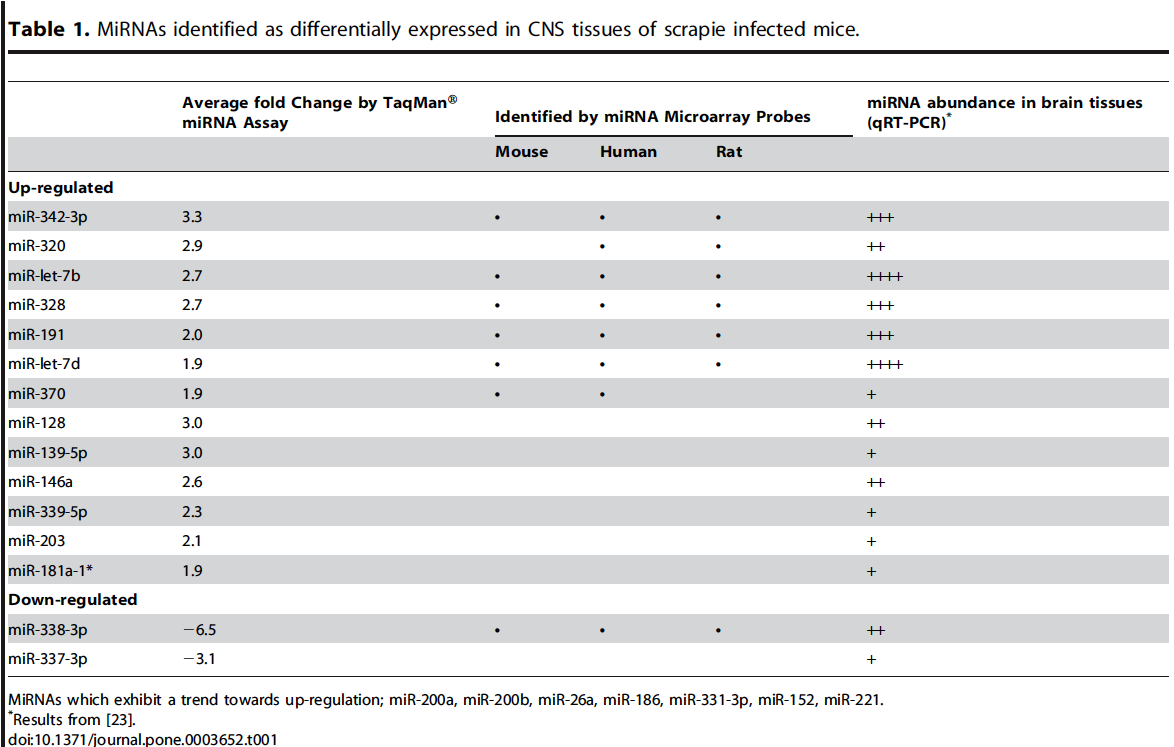
This web page was produced as an assignment for an undergraduate course at Davidson College.
The authors open with a compelling explanation of why prion diseases warrant study (after all, they are “invariably fatal”) and do a good job advising the reader to be careful ascribing causation between miRNAs and prion-induced neurodegeneration; ultimately, however, the authors suggest that the majority of miRNAs studied seem to exert an effect on genes through down-regulation. They explore this correlation relatively fully, but the figures are the paper’s Achilles heel. They are extremely difficult to follow and are poor illustrations of the points the authors are making in the paper; ultimately the figures really limit the authors from making a compelling argument. A more detailed analysis of each figure follows.

Table 1 shows the miRNAs that the authors studied whose expression levels were most clearly related to prion-disease neurodegeneration; the most important value in the table is the fold change in expression level in scrapie-infected mouse nervous system tissue versus wild-type. The table classifies the miRNAs according to whether they were, on the whole, up- or down-regulated. The authors do not explain how they chose these 15 miRNA types to represent in the table. The table has no legend explaining the interpretation of the results, and the text from the body of the paper is circuitous and confusing: they state that of 14 miRNAs studied they chose “7/8 up-regulated miRNAs and 1/6 down-regulated miRNAs, shown in Table 1” identified from an in-house custom microarray, and a paragraph later add that there were six more up-regulated miRNAs and one more down-regulated miRNA determined by TaqMan RT-PCR, which they added to Table 1. This, it becomes apparent, is what the column “Identified by miRNA Microarray Probes” is intended to show. Finally, the table also shows the relative abundance of each miRNA in brain tissues as determined by qRT-PCR, denoted by plus signs; the authors do not describe what the number of plus signs means—whether this is some kind of absolute measurement, or a quantification relative to the other miRNAs in the table, or what. My questions that remain after seeing this, then, are: Why did the authors use two different methods to determine inclusion in the table? Should this affect my understanding of the roles of each miRNA? And what exactly do the plus signs mean?
Figure 1
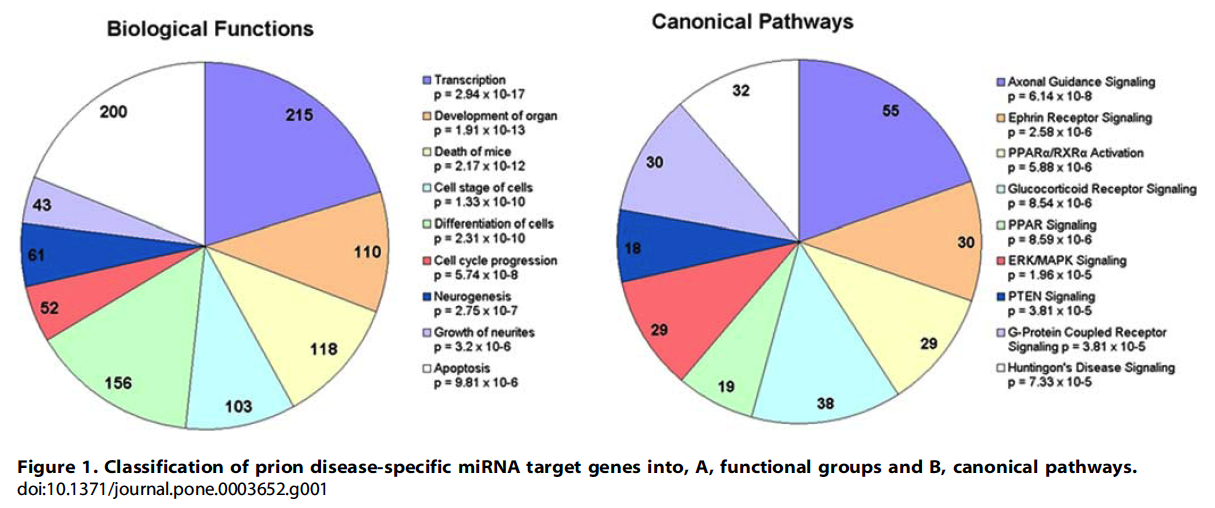
The authors ran three computer programs that predicted which genes would be affected by the de-regulated miRNAs based on 3’ end UTR sequence homology, and only included genes that were predicted by at least two of their three programs. Figure 1 shows the genes in this group that had been annotated in the Ingenuity Pathway analysis database, classifying the genes in two ways: by biological function on the left, and by canonical pathway on the right. Only the categories that were “most enriched” were included in the circle graphs; the authors do not explain whether these categories were selected by number alone, or by percentage of target genes compared to the size of the category—or some other selection mechanism entirely. Also, the authors pay special attention in the text to the UPS pathway involved in Parkinson’s and Huntington’s diseases, but the figure calls what appears to be the same category of genes “Huntington’s Disease Signaling” genes. Is this the same group? A subset? A larger set?
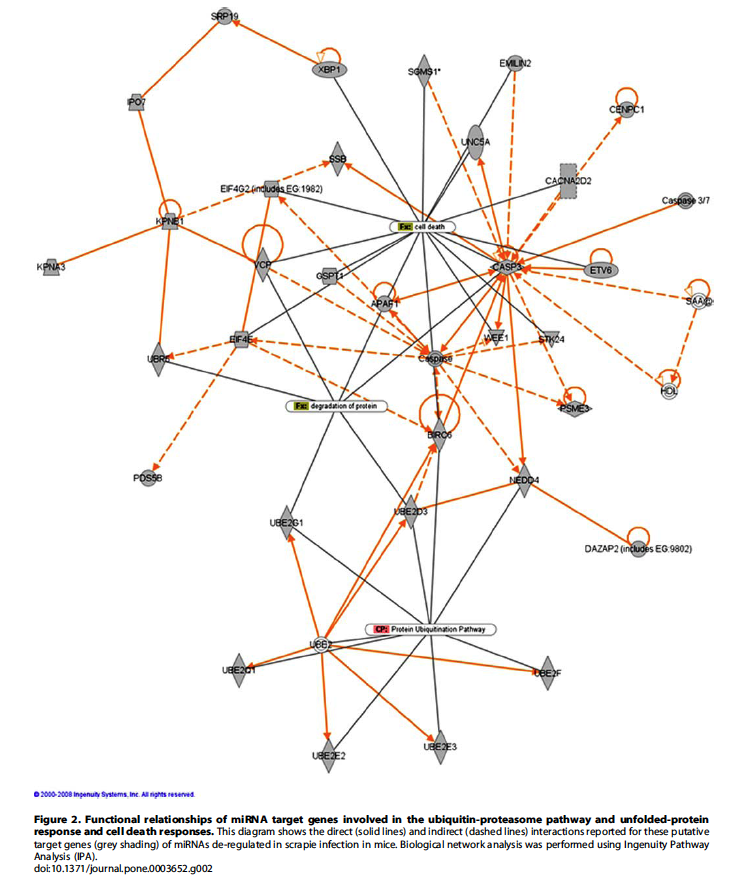
Figure 2 illustrates the “high degree of interactions” between predicted miRNA target genes and pathways that are involved in cell death, protein degradation, and protein ubiquitination. The grey nodes are the target genes as predicted above; they are connected either directly (by solid line) or indirectly (by dotted line) to three different pathways, which are the white text boxes. This is straightforward and easy to understand, although no mention is made in the figure or in the text of why the target genes are associated with about ten different geometric shapes, or whether these differences bear any significance to the reader.
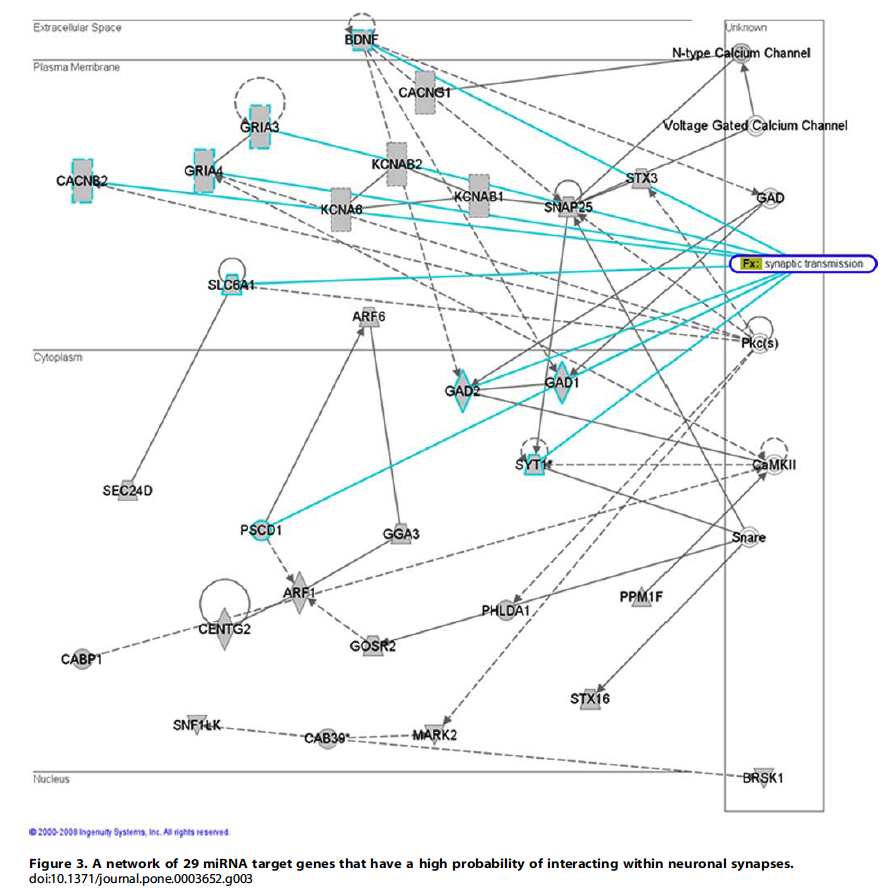
Like Figure 2, Figure 3 shows target genes of a certain sort—in this case, ones that “have a high probability of interacting with neuronal synapses”—and how they interact with the synaptic transmission pathway. Again, solid lines show direct interactions and dotted lines show indirect interactions. The figure also shows where these target genes are generally expressed, whether it is in extracellular space, the plasma membrane, the cytoplasm, or the nucleus, or an unknown domain. The text draws attention to SNAP-25, which occupies a relatively central position in the figure and is down-regulated by miR-128; the authors suggest that the loss of SNAP-25p by the actions of miR-128 (which is up-regulated in this study) may be causally related to the neurodegeneration of scrapie-infected mice.
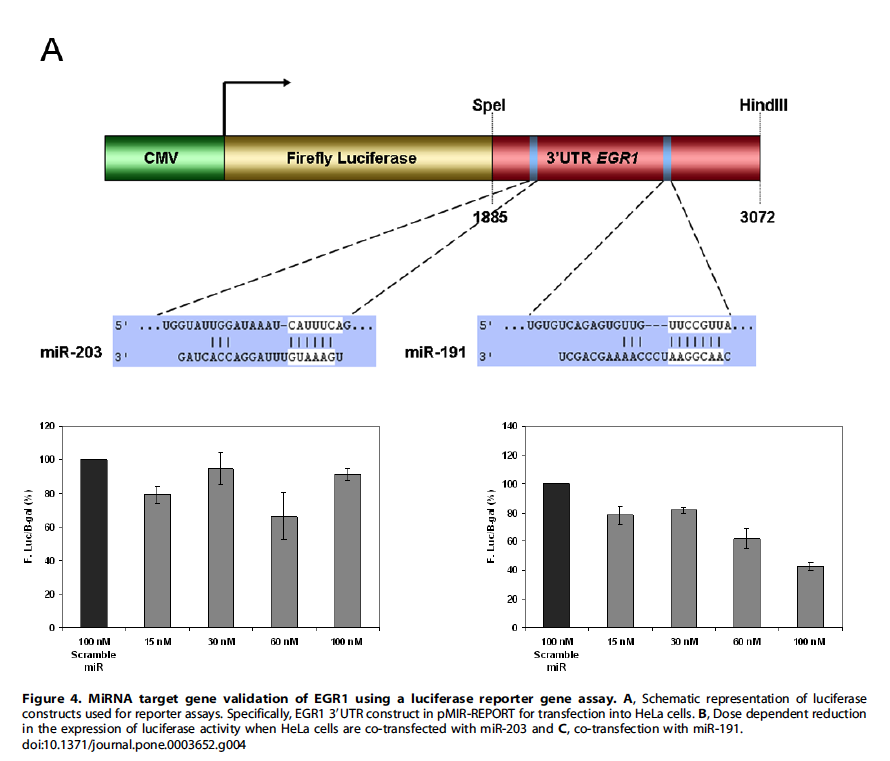
Figure 4 is a confusing one. The authors only give one sentence of explanation in the text, and few details in the figure legend. The figure shows a model of the construct the authors used to show that miR-191 is a potential regulator of EGR1, while miR-203 is not. They designed a construct using CMV—a promoter? they don’t say—firefly luciferase (a reporter gene), and the 3’ UTR of EGR1 flanked by the two miRNAs they were studying, miR-191 and miR-203. The authors do not explain how the construct works, or how the two graphs, labeled B and C in the legend but unlabeled in the figure itself, show that miR-191 does regulate EGR1 while miR-203 does not. In a way I guess I like it more that they don’t explain, because I have to really think about what’s going on—but I confess I don’t understand what Scramble miR is, or why 100 nM of Scramble miR (the black bar) is different from 100 nM of whatever else was measured (the grey bar on the right of each graph). More explanation would absolutely be a good thing for this figure.
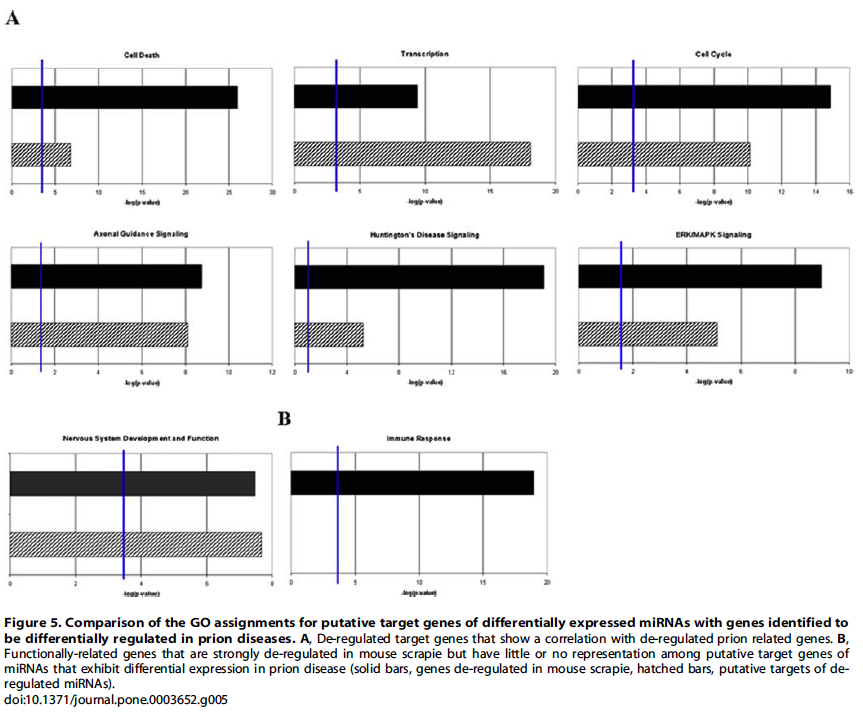
Figure 5 shows the links between miRNA target genes and genes separately identified to be differentially expressed in scrapie. Each graph represents a different functional group of genes; the solid black bars denote genes that are de-regulated in scrapie, and the hatched bars represent the predicted miRNA-deregulated target genes. The length of the bars indicates the –log of the p-value; higher –log values indicate a smaller chance that the correlation is coincidental. The authors do not say, and I do not know, what the blue lines denote. We are supposed to see that the most strongly correlated pathways involve cell death, cell cycle, neuronal development and function, and signaling pathways. All of the graphs under A show a correlation between the two; the immune response genes, labeled B, are the only ones that do not seem to be correlated. The authors investigate the immune response genes further in Figure 6.
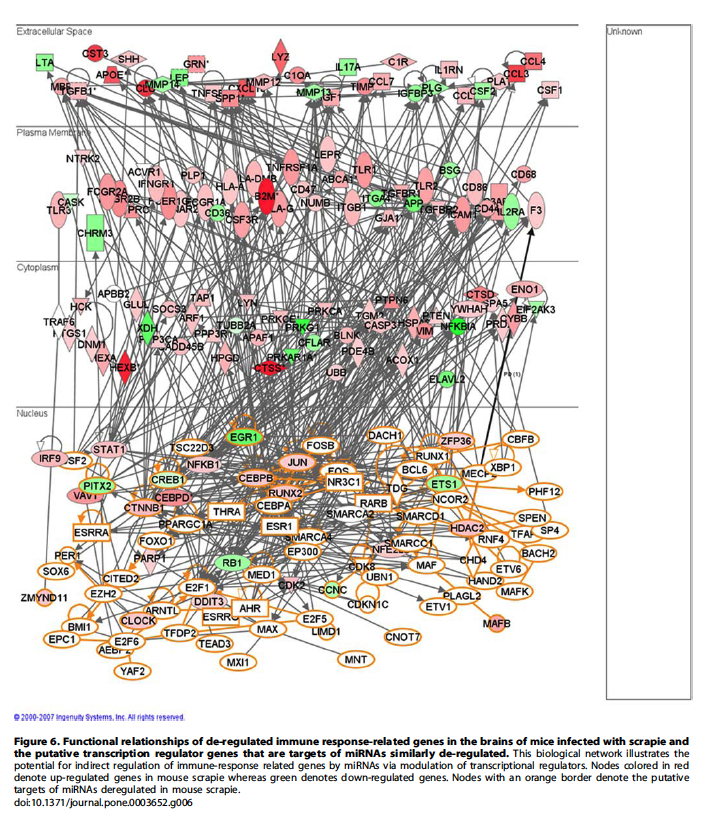
Figure 6 shows the network of immune response genes differentially regulated in mice with scrapie, and the transcription factor genes predicted to be targeted by miRNA. The miRNA target genes have orange borders, while the immune response genes are red if down-regulated, and green if up-regulated. The graph is too complex to easily get much information out of it; the legend in the graph claims that only de-regulated genes shared a functional relationship with de-regulated miRNA target genes, although it looks like green nodes as well as red are equally integral to the network. Like Figure 3, the genes are segregated according to where they are expressed—in the nucleus at the bottom, which contains all of the miRNA target genes, or in the cytoplasm, the plasma membrane, or extracellular space. The complexity of this graph precludes the reader from forming any clear conclusions from it; the only way it strengthens the authors’ message is by showing that transcription factors do interact with immune response genes, thus showing that the correlation between immune response genes and miRNA target genes does exist indirectly.
Saba R, Goodman CD, Huzarewich RLCH, Robertson C, Booth SA. (2008). A miRNA Signature of Prion Induced Neurodegeneration. PLoS ONE 3(11):
e3652. doi:10.1371/journal.pone.0003652